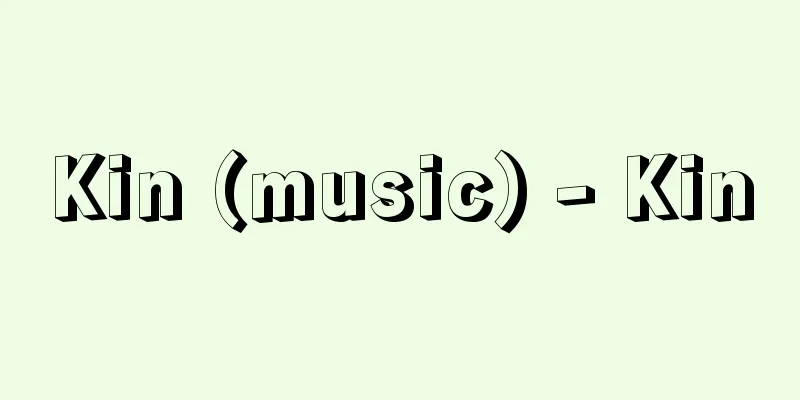Sperm

|
The male gamete of a multicellular organism that has motility. Also called a spermatozoa. First described by Leeuwenhoek in 1667, spermatozoa gave rise to the preformation theory, which posits that extremely small animals are incorporated into sperm. [Amanami Amemiya] Form and FunctionThe basic structure of a sperm consists of a part that functions to penetrate the egg at the time of fertilization (acrosome), a part that functions for heredity (nucleus), a part that functions as a respiratory organ (mitochondria), and a part that functions as a locomotor organ (flagellum). The acrosome and nucleus form the head, the mitochondria form the midpiece, and the flagellum forms the tail. In many mammalian sperm, the head and midpiece are constricted to form a neck. Some crustacean sperm are known to be tripod-shaped or amoeba-shaped, without this structure. Sperm are a single cell, but as a cell it is highly specialized, with the nucleus taking up the majority of the cell and most of the cytoplasm missing. During fertilization, the acrosome reacts with substances on the surface of the egg, causing the acrosome reaction and releasing a substance that dissolves the egg membrane contained in the acrosome. This substance dissolves the egg membrane and opens a hole for the sperm to enter the egg. Sperm nuclei contain haploid ( n ) chromosomes, and therefore the amount of DNA (deoxyribonucleic acid) is half that of somatic cell nuclei. Most sperm contain protamine instead of histone as a basic protein in the nucleus. Chromosomes are present in a very dense state in sperm nuclei, making it difficult to observe their pattern using an electron microscope. At the time of fertilization, the sperm nucleus that enters the egg fuses with the egg nucleus to have polyploid ( 2n ) chromosomes. Mitochondria contained in the middle piece provide energy for sperm movement. Most sperm mitochondria are doughnut-shaped or spiral-shaped. Sperm flagella, like other flagella and cilia, have a basic structure of 9+2 axonemes (two axonemes in the center of nine pairs of axonemes arranged in a circle), and use the energy of ATP (adenosine triphosphate) supplied through mitochondria to perform flagellar movement and move sperm. It is known that if isolated flagella are treated with a surfactant to destroy the membrane and then ATP is added, they will still be able to move on their own. [Amanami Amemiya] The process of sperm formationPrimordial germ cells that will differentiate into spermatozoa arise quite early in development and then migrate to the testes where spermatogonia are differentiating elsewhere. These spermatogonia grow by mitosis, then stop dividing and grow to become primary spermatocytes. Primary spermatocytes undergo meiosis to become secondary spermatocytes, and then divide once more to become spermatids. As a result, one spermatocyte produces four spermatids. During this meiosis, the number of chromosomes is halved to become haploid ( n ). The process by which spermatozoa are formed from spermatids is called spermiogenesis, or sperm metamorphosis. During this process, the nuclei in the spermatids are significantly condensed and chromosomes are packed in, the acrosomes form from the Golgi apparatus, the flagella form from the centrioles, and the mitochondria are located in the midpiece. Most of the remaining cytoplasm is released and the spermatozoa are completed. [Amanami Amemiya] Sperm motility energyIn mammals, the energy for sperm movement is obtained through glycolysis from the sugars contained in the seminal plasma (the part of semen excluding sperm), but in the sperm of marine animals that are released into the water, ATP is produced using the substrates glycogen, phospholipids, and sulfolipids (sulfur-containing lipids) contained in the sperm. The meeting of sperm and eggs is generally considered to occur randomly, but some types of sperm exhibit chemotaxis. [Amanami Amemiya] Plant spermMost plants do not produce sperm, but some green algae, brown algae, charophytes, and blue-green algae produce sperm, and ferns and mosses also produce sperm. Among seed plants, the discovery of sperm in ginkgo (Hirase Sakugoro, 1898) and cycad (Ikeno Seiichiro, 1898) is well-known. The morphology of plant sperm varies depending on the species, but all have flagella or cilia as organelles for movement. At the base of these flagella and cilia is a trichome, an organelle homologous to the centrosome. [Amanami Amemiya] Human spermSperm are produced in the epithelium of the seminiferous tubules of the testis through the differentiation of spermatogonia, primary spermatocytes, secondary spermatocytes, spermatids, and spermatozoa. It is said that it takes about 74 days for spermatogonia to differentiate into spermatozoa. Human sperm are tadpole-shaped, about 50 to 60 micrometers in total length, and consist of four parts: head, neck (junction), body (midpiece, intermediate part), and tail. The head is almost an ellipsoid, and is roughly divided into the head parenchyma (nucleoplasm) and cap (acrosom). The cap at the tip of the sperm head contains an enzyme that dissolves the surface of the egg, and plays an important role in fertilization. The head parenchyma is made up of the nucleus of the cell, and as a result of meiosis, it has half the amount of DNA protein as a somatic cell. There are sperm with an X chromosome and sperm with a Y chromosome, and eggs only have an X chromosome, so the sperm have the power to determine sex. The neck is a part that continues to the head, and contains the centrosome. The components that make up the centrosome are a group of microtubule structures, which consist of a pair of central microtubules in the center and nine pairs of peripheral microtubules that surround them, and these play an important role in the flagellar movement of sperm. Sperm mature in the epididymis and are stored in the tail of the epididymis. When sexual arousal increases, the peristaltic movement of the vas deferens rapidly transports them through the vas deferens to the ampulla of the vas deferens. Sperm are not motile until ejaculated. Sperm are generally sensitive to acid, but are active in a slightly alkaline environment. The amount of sperm ejaculated in one ejaculation is 1-6cc, and it is considered normal if there are more than 20 million sperm per cc. It is also considered normal if more than 50% of sperm are of normal morphology and more than 50% are motile (WHO standards). [Masafumi Shirai] ©Kanzo Otawa "> Sperm morphology and structure ©Kanzo Otawa "> Examples of sperm shapes Source: Shogakukan Encyclopedia Nipponica About Encyclopedia Nipponica Information | Legend |
|
多細胞生物の雄性配偶子で、運動性をもつものをいう。精虫ともよぶ。1667年にレーウェンフックによって初めて記載され、当時、精子の中に極微動物が組み込まれていると考える前成説を生じた。 [雨宮昭南] 形態と機能精子の基本的な形態は、受精時における卵への侵入のための機能をもつ部分(先体)、遺伝のための機能をもつ部分(核)、呼吸器官として働く部分(ミトコンドリア)、および運動器官として働く部分(鞭毛(べんもう))からなり、先体および核は頭部を、ミトコンドリアは中片を、鞭毛は尾部を形成する。哺乳(ほにゅう)類の精子などでは、頭部と中片の間がくびれて、頸(けい)部を形成するものも多い。甲殻類の精子のなかには、このような構造をとらずに、三脚型やアメーバ型になるものも知られている。精子は1個の細胞であるが、細胞としてはきわめて特殊化したもので、核がその主要部分を占めており、細胞質の大部分は失われている。先体は、受精時に卵表面物質と反応して先体反応をおこし、先体中に含まれる卵膜溶解物質を放出する。この物質は卵膜を溶かして、精子が卵に侵入するための穴をあける。精子核中には半数体(n)の染色体が含まれ、したがって、DNA(デオキシリボ核酸)の量も体細胞核に含まれるDNA量の半分である。多くの精子では、核内の塩基性タンパク質としてヒストンのかわりにプロタミンを含んでいる。染色体は、精子核中では非常に密な状態で存在しており、電子顕微鏡などを用いて、その存在様式を観察するのはむずかしい。受精時に、卵の中に入った精子核は、卵核と融合することによって、倍数体(2n)の染色体をもつようになる。中片に含まれるミトコンドリアは、精子が運動するためのエネルギーを供給する。精子ミトコンドリアの形態は、ドーナツ形や螺旋(らせん)形をとるものが多い。精子鞭毛は、他の鞭毛や繊毛と同様に9+2の軸糸(円形に配列した9組の軸糸の中央に2本の軸糸がある)としての基本構造をもち、ミトコンドリアを経て供給されるATP(アデノシン三リン酸)のエネルギーを用いて鞭毛運動を行い、精子を動かす。分離した鞭毛を界面活性剤で処理して膜を破壊したあと、ATPを加えれば、分離した状態でも鞭毛運動を行うことが知られている。 [雨宮昭南] 精子の形成過程将来、精子に分化する始原生殖細胞は、発生のかなり早い時期に生じたあとに移動して、別の場所で分化している精巣中に入って精原細胞となる。この精原細胞は有糸分裂によって増殖したのち、分裂をやめて成長し、第1次精母細胞になる。第1次精母細胞は、減数分裂を行って第2次精母細胞となり、さらにもう1回分裂して精細胞になる。この結果、1個の精母細胞から、4個の精細胞が生じることになる。この減数分裂の過程で、染色体数は半減して半数体(n)になっている。精細胞から精子が形成される過程は、精子完成、または精子変態という。この過程で、精細胞中の核は、著しく凝縮して染色体が詰め込まれ、ゴルジ装置から先体が、中心粒から鞭毛が生じ、ミトコンドリアが中片に位置するようになる。その他の細胞質の大部分は放出されて精子が完成する。 [雨宮昭南] 精子運動のエネルギー哺乳類などでは、精漿(せいしょう)(精液から精子を除いた部分)中に含まれる糖から解糖によって精子運動のエネルギーを得るが、水中に放精される海産動物の精子などでは、精子中に含まれるグリコーゲン、リン脂質、硫黄(いおう)を含む脂質であるスルホリピドなどを基質としてATPを生ずる。精子と卵の会合は、一般には無作為におこるとされているが、ある種の精子では、走化性の認められるものもある。 [雨宮昭南] 植物の精子植物の多くは精子をつくらないが、緑藻類、褐藻類、車軸藻類、藍藻(らんそう)類などには精子をつくるものがあり、シダ植物やコケ植物も精子をつくる。種子植物ではイチョウ(平瀬作五郎・1898)、ソテツ(池野成一郎・1898)での精子の発見が有名である。植物精子の形態は種によってさまざまであるが、いずれも運動器官として鞭毛または繊毛をもっている。これらの鞭毛や繊毛の基部には、中心体と相同の器官である毛生体が存在している。 [雨宮昭南] ヒトの精子精巣(睾丸(こうがん))の精細管上皮から精祖細胞→第1次精母細胞→第2次精母細胞→精子細胞→精子の順に分化してつくられる。この精祖細胞から精子に分化するまで約74日を要するといわれている。ヒトの精子はオタマジャクシ形で、全長がおよそ50~60マイクロメートルの大きさであり、頭部、頸(けい)部(結合部)、体部(中片、中間部)および尾部の四部からなる。頭部は楕円(だえん)球形に近く、頭部実質(核質部)と頭帽(先体)に大別される。精子の頭部先端にある頭帽には卵(らん)の表層を溶解させる酵素が含まれており、受精に重要な役割を演ずる。また、頭部実質は細胞の核よりなり、減数分裂の結果、体細胞の2分の1量のDNAタンパクを有している。精子にはX染色体を有する精子とY染色体を有する精子とがあり、卵にはX染色体しかなく、性の決定権は精子側にある。頸部は頭部に連続する部分で、中心体が存在する。中心体を構成する成分は微小管構造群で、これは中心にある1対の中心微小管とそれらを取り巻く9対の周辺微小管からなり、これらは精子の鞭毛運動に重要な働きをしている。 精子は、精巣上体(副睾丸)で成熟し、精巣上体の尾部に蓄えられる。性的興奮が高まると、精管の蠕動(ぜんどう)運動によって精管内を速やかに精管膨大部へと送られる。精子は射精されるまでは運動しない。一般に精子は酸に弱いが、弱アルカリ性の環境では活発に運動する。1回の射精量は1~6ccで、1cc中に精子が2000万以上あれば正常である。また、正常形態の精子が50%以上、運動している精子が50%以上あれば正常である(WHO基準)。 [白井將文] ©大多和鐘三"> 精子の形態と構造 ©大多和鐘三"> 精子の形状の例 出典 小学館 日本大百科全書(ニッポニカ)日本大百科全書(ニッポニカ)について 情報 | 凡例 |
Recommend
Eosin
Eosin Y and Eosin B are known. [ I ] Eosin Y: C 2...
Oiwakecho ruins
...It is located on the Kitashirakawa alluvial fa...
Seafood and mountain delicacies
One of the myths found in the Kojiki and Nihon sho...
Interpretation (English)
In interpreting the law, the meaning of the words ...
Odawara stories
…It is also called Odawara Dango or Odawara Banas...
Aristomedes - Aristomedes
…Horses and cattle sometimes have bones in their ...
Dzhalita
...It is a leading resort and tourist destination...
Milk mushroom - Milk mushroom
An edible mushroom of the Basidiomycete family, R...
Eutectoid crystal
① Eutectoid point : A mixture of two or more diffe...
Chestnut - Chestnut (English spelling)
A general term for the genus Castanea, family Fag...
Cloth - Nunoko
〘Noun〙 Cotton padding. In the old days, it referre...
Danton - Georges-Jacques Danton
French politician. Born to a wealthy farmer in th...
Sauce tomate (English spelling)
...Add an equal amount of stock to this, simmer u...
Subodhini (English spelling)
...He later married and had a son, Viṭṭhalanātha,...
Iwaki [town] - Iwaki
A former town in Nakatsugaru District, Aomori Pref...





![Shikano [town] - Shikano](/upload/images/67cb3b8987802.webp)



